National Bison Range
The National Bison Range (BR) is a nature reserve on the Flathead Indian Reservation in western Montana established as a wildlife conservation area for the American bison. The size of the bison herd at the BR is between 350 and 500. The range serves as the central point for bison research in the United States.
| National Bison Range | |
|---|---|
IUCN category IV (habitat/species management area) | |
 | |
 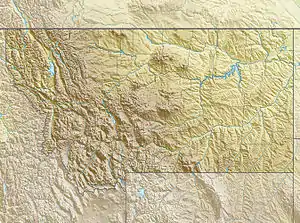 | |
| Location | Lake / Sanders counties, Montana, USA |
| Nearest city | Missoula, MT |
| Coordinates | 47°19′30″N 114°13′33″W[1] |
| Area | 18,800 acres (76 km2) |
| Established | 1908 |
| Visitors | est. 250,000 (in 2004) |
| Governing body | Confederated Salish and Kootenai Tribes |
| Website | www |
Established as a National Wildlife Refuge established in 1908, the BR consists of approximately 18,800 acres (7,600 ha). The management is in the process of being transferred from the U.S. Fish and Wildlife Service to the Confederated Salish and Kootenai Tribes. Other nearby National Wildlife Refuges are managed as parts of the Western Montana National Wildlife Refuge Complex and includes the Lost Trail, Ninepipe, Pablo and the Swan River National Wildlife Refuges. Also affiliated is the Northwest Montana Wetland Management District.[2][3]
The BR has a visitor center, and two scenic roads that allow vehicular access to prime viewing areas. The range is approximately one hour north of Missoula, Montana off of U.S. Highway 93 directing visitors to the entrance at Moiese, Montana, and the range headquarters.
History
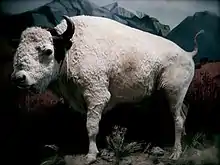
The National Bison Range was established in 1908 out of a portion of the Flathead Indian Reservation.[4] The Range was established as a native bird refuge by Congress in 1921.[4] The Civilian Conservation Corps built many of its buildings. The initial herd of American bison was purchased with funds provided by the American Bison Society. Ernie Kraft, who began work at the Bison Range in 1955, published a history of the Bison Range and its people in 2006.[5]:1, 14, 18–22
A white buffalo, "Big Medicine" (1933-1959, also called "Whitey"), spent his life at the Bison Range.[5]:70–73 Tribal members visited him many times and held him in high esteem.[6]
Returning the range to tribal control has been desired by members since it was taken over by the federal government and the tribe has submitted three proposals since 1994 to that end.[7] The Consolidated Appropriations Act, 2021 began a two-year transition process when it became law on December 27, 2020.[8] With the Bureau of Indian Affairs (BIA) taking the land into trust for the Confederated Salish and Kootenai Tribes (CSKT), the range is restored to the Flathead Indian Reservation.[9] Assistant Secretary Tara Katuk Sweeney stated that “The CSKT have strong and deep historical, geographic and cultural ties to the land and the bison, and their environmental professionals have been leaders in natural resources and wildlife management for many decades.”[9]
Geology
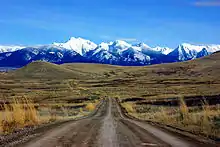
The range is a small, low-rolling mountain connected to the Mission Mountain Range by a gradually descending spur. Range elevation varies from 2,585 feet (788 m) at headquarters to 4,885 feet (1,489 m) at High Point on Red Sleep Mountain, the highest point on the Range. Much of the Bison Range was once under prehistoric Glacial Lake Missoula, which was formed by a glacial ice dam on the Clark Fork River about 13,000 to 18,000 years ago. The lake attained a maximum elevation of 4,200 feet (1,300 m), so the upper part of the Range was above water. Old beach lines are still evident on north-facing slopes. Topsoil on the Range is generally shallow and mostly underlain with rock which is exposed in many areas, forming ledges and talus slopes. Soils over the major portion of the Range were developed from materials weathered from strongly folded pre-Cambrian quartzite and argillite bedrock.[10]
Ecology

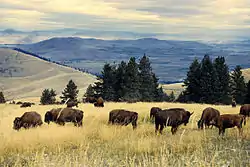
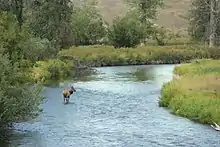
The range protects one of most endangered ecosystems in North America, the intermountain bunchgrass prairie.[11] In addition to the 350 to 500 bison on the Bison Range, many other mammal species may be seen on the refuge, including coyote, black bear, elk, mule deer, bighorn sheep, white-tailed deer, pronghorn, mountain cottontail, Columbian ground squirrel, muskrat, yellow-pine chipmunk, badger, and cougar.[12] Over two hundred bird species have been seen on the refuge.[13] The Bison Range also contains many plant species, including the bitterroot, ponderosa pine, and buffalo grass.[14]
Prior to the 1800s, bison were believed to number in the tens of millions, they once were found in all the current U.S. states, except Hawaii, and also throughout Canada.[15]
Bison were nearly extinct by 1890, having been part of a Federal government sponsored program of eradication during the Indian Wars, thereby removing a vital food source from the Plains Indians diet, and ensuring easier relocation onto Indian reservations.[16]
References
- "National Bison Range". Geographic Names Information System. United States Geological Survey. Retrieved February 22, 2014.
- Ravalli, MT (Map). Topoquest (USGS Quads). Retrieved February 22, 2014.
- "Annual Report of Lands Under Control of the U.S. Fish and Wildlife Service" (PDF). U.S. Fish and Wildlife Service. September 30, 2010. p. 23. Retrieved February 22, 2014.
- Endersby, Holly (2019-08-01). "Roaming Free on the National Bison Range". Montana Senior News. Retrieved 2020-11-12.
- Kraft, Ernest (2006). Untold tales of Bison Range trails. Stevensville, Montana: Stoneydale Press Publishing Co. ISBN 1931291527. OCLC 70272174.
- "What makes the National Bison Range, and its relation to the Confederated Salish and Kootenai Tribes, so unique?". Bison Range Restoration. Confederated Salish and Kootenai Tribes. Retrieved 2021-01-26.
- Scheer, Laura (January 22, 2021). "Confederated Salish and Kootenai Tribes plan future of National Bison Range". Missoulian. Retrieved 2021-01-27.
- "Montana's National Bison Range transferred to tribes". NBC News Montana. January 18, 2021. Retrieved January 21, 2021.
-
 This article incorporates public domain material from the U. S. Department of the Interior document: "National Bison Range transitions into tribal trust for the Flathead Indian Reservation". Char-Koosta News. January 21, 2021. Retrieved 2021-01-24.
This article incorporates public domain material from the U. S. Department of the Interior document: "National Bison Range transitions into tribal trust for the Flathead Indian Reservation". Char-Koosta News. January 21, 2021. Retrieved 2021-01-24. - About the Refuge, March 12, 2013, viewed November 6, 2013, U.S. Fish and Wildlife Service, http://www.fws.gov/refuge/National_Bison_Range/about.html
- "Capturing 40 years of climate change for an endangered Montana prairie". phys.org. Public Library of Science. December 23, 2020. Retrieved 2020-12-25.
- Mammals - National Bison Range - U.S. Fish and Wildlife Service, 6 Feb. 2013. Web. 06 Nov. 2013. http://www.fws.gov/refuge/national_bison_range/wildlife_and_habitat/Animals.html
- "Birds of National Bison Range" (PDF). U.S. Fish and Wildlife Service. Retrieved February 2, 2020.
- Plants of the National Bison Range, September 1985, viewed November 6, 2013, U.S. Fish and Wildlife Service, http://www.fws.gov/uploadedFiles/NBR%20plant%20list.pdf
- Bureau of Sport Fisheries and Wildlife (January 1965). "The American Buffalo". Conservation Note. 12.
- Smits, David (Autumn 1994). "The Frontier Army and the Destruction of the Buffalo: 1865–1883" (PDF). The Western Historical Quarterly. 25 (3): 312–338. doi:10.2307/971110. JSTOR 971110. Retrieved March 30, 2015.
External links
| Wikimedia Commons has media related to National Bison Range. |
- Bison Range Restoration (Confederated Salish and Kootenai Tribes)
- National Bison Range Oral History Project (University of Montana Archives)